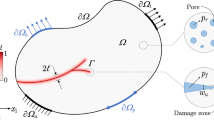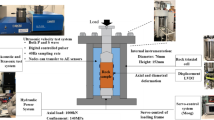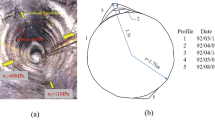Abstract
Fluids saturating cracked rocks within the crust can vary widely in composition and physical properties, which depend greatly on pressure and temperature. External non-hydrostatic stress applied to a cracked medium may result in a significant change of crack volume (and hence, for the undrained regime, pore-fluid pressure) due to the processes of crack closure (opening), and thus lead to a drastic change of the overall physical parameters of a rock. The purpose of the study is to estimate theoretically, using the effective-medium theory, the macroscopic seismic and transport parameters (such as permeability) of cracked rocks (granites) saturated with hydrocarbon gases, oils, brines and water. Variations of crack geometry and fluid parameters in the closed system (at constant fluid mass) under uniaxial compression are considered as well. The results show that composition of a saturating fluid as well as fluid temperature greatly influence the effective permeability and shear velocities of a rock mass, while thermal conductivity is not so sensitive to variations of fluid parameters.
Similar content being viewed by others
References
Artemieva, I. M. and Chesnokov, E. M.: 1991, ‘Thermal Characteristics of Anisotropic Media with Inclusions’,Geophys. J. Int. 107, 557–562.
Artemieva, I. M. and Zatsepin, S. V.: 1992, ‘Thermal Conductivity and Permeability of Pre-stressed Cracked Media’, in G. Buntebarth (ed.)Thermal Properties of Crustal Materials, Sitzungsberichte der 22 Sitzung der FKPE-Arbeitsgrupper, Germany, Bad-Honnef,22, 31–53.
Batzle, M. and Wang, Z.: 1992, ‘Seismic Properties of Pore Fluids’,Geophysics 57, 1396–1408.
Brodholt, J. and Wood, B.: 1993, ‘Simulations of the Structure and Thermodynamic Properties of Water at High Pressures and Temperatures’J. Geophys. Res. 98, 519–536.
Burnham, C. W., Holloway, J. R., and Davis, N. F.: 1969, ‘The Specific Volume of Water in the Range 1000 to 8900 Bars, 20–900°C’,Am. J. Sci. 267-A, 70–95.
Chen, C. T., Chen, L. S., and Millero, F. T.: 1978, ‘Speed of Sound in NaCl, MgCl2 Na2SO4, and MgSO4 Aqueous Solutions as Functions of Concentration, Temperature, and Pressure’,J. Acoust. Soc. Am. 63, 1795–1800.
Chesnokov, E. M. and Zatsepin, S. V.: 1991, ‘Effects of Applied Stress on Effective Elastic Anisotropy in Cracked Solids’,Geophys. J. Int. 107, 563–569.
Christensen, N. I.: 1989, ‘Pore Pressure, Seismic Velocities, and Crustal Structure’, in L. C. Pakisser and W. D. Mooney (eds.), Geophysical framework of the continental United States, Boulder, Colorado,Geol. Soc. Am. Memoir 172, 783–800.
Crampin, S.: 1984, ‘Effective Elastic Constants for Wave Propagation through Cracked Solids’,Geophys. J. R. Astron. Soc. 76, 135–145.
Crampin, S.: 1987. ‘Geological and Industrial Implications of Extensive-Dilatancy Anisotropy’,Nature 328, 491–496.
Crampin, S.: 1990, ‘Alignment of Near-Surface Inclusions and Appropriate Crack Geometries for Geothermal Hot-Dry-Rock Experiments’,Geophys. Prosp.38, 621–631.
David, C., Guéguen, Y., and Pampoukis, G.: 1990, ‘Effective Medium Theory and Network Theory Applied to the Transport Properties of Rock’,J. Geophys. Res. 95, 6993–7005.
Doyen, P. H.: 1987, ‘Crack Geometry in Igneous Rocks: A Maximum Entropy Inversion of Elastic and Transport Properties’,J. Geophys. Res. 92, 8169–8181.
Eshelby, J. D.: 1957, ‘The Determination of the Elastic Field of an Ellipsoidal Inclusion and Related Problems’,Proc. Roy. Soc. London A241, 376.
Etheridge, M.A.: 1983, ‘Differential Stress Magnitudes During Regional Deformation and Metamorphism: Upper Bound Imposed by Tensile Fracturing’,Geology 11, 231–234.
Etheridge, M. A., Cox, S. F., Wall, V. J., and Vernon, R. H.: 1984, ‘High Fluid Pressure Duri Regional Metamorphism and Deformation: Implications for Mass Transport and Deformation Mechanisms’,J. Geophys. Res. 89, 4344–4358.
Evans, A. G.: 1978, ‘Micro-Fracture from Thermal Expansion Anisotropy. — I. Single-Phase Systems’,Acta Metallurgica 26, 1845–1853.
Fyfe, W. S., Price, N. J., and Thompson, A. B.: 1978,Fluids in the Earth's Crust, Elsevier, Amsterdam-Oxford-New York, 435 pp.
Gavrilenko, P. and Gueguen, Y.: 1989, ‘Pressure Dependence of Permeability: A Model for Cracked Rocks’,Geophys. J. Int. 98, 159–172.
Glover, P. W. J. and Vine, F. J.: 1995, ‘Beyond KTB-Electrical Conductivity of the Deep Continental Crust’,Surveys in Geophysics 16, 5–36.
Glover, P. W. J., Baud, P., Darot, M., Meredith, P. G., Boon, S. A., LeRavalec, M., Zoussi, S., and Reuschlé, T.: 1995, ‘α/β Phase Transition in Quartz Monitored using Acoustic Emissions’,Geophys. J. Int. 120, 775–782.
Gretener, P. E.: 1977, ‘Pore Pressure: Fundamentals, General Ramifications, and Implications for Structural Geology’, AAPG, Tulsa, OK., 1977.
Hadley, K.: 1976. ‘Comparison of Calculated and Observed Crack Densities and Seismic Velocities in Westerly Granite’.J. Geophys. Res. 81, 3484–3494.
Helgeson, H. C. and Kirkham, D.: 1974, ‘Theoretical Prediction of the Thermodynamic Behaviour of Aqueous Electrolytes’,Am. J. Sci. 274, 1098–1198.
Hudson, J. A.: 1980, ‘Overall Properties of a Cracked Solid’Math. Proc. Camb. Phil. Soc.,88, 371–384.
Hudson, J. A.: 1986, ‘A Higher Order Approximation to the Wave Propagation Constants for a Cracked Solid’,Geophys. J. R. Astron. Soc. 87, 265–274.
Keenen, J. H., Keyes, F. G. Hill, P. G., and Moore, J. G.: 1969,Steam Tables, John Wiley & Sons Inc.
Kestin, J., Khalifa, H. E., and Correia, R.JJ.: 1981, ‘Tables of the Dynamic and Kinematic Viscosity of Aqueous NaCl Solutions in the Temperature Range 20–150°C and the Pressure Range 0.1–35 MPa’,J. Phys. Chem. Ref. Data 10, 71–74.
Koplik, J.: 1981, ‘On the Effective Medium Theory of Random Linear Networks’,J. Phys. C. 14, 4821–4837.
Kozlovsky, E. A.: 1984, Kola Superdeep, Moscow, Nedra (in Russian), 490 pp.
Kranz, R. L.: 1983, ‘Micro-Cracks in Rocks: A Review’,Tectonophysics 100, 449–480.
Lachenbruch, A. H. and Sass, J. H.: 1977, ‘Heat Flow in the United States and the Thermal Regime of the Crust’,Geophys. Monogr. Ser. 20, 626–675.
LeRavalec, M. and Guéguen, Y.: 1994, ‘Permeability Models for Heated Saturated Igneous Rocks’,J. Geophys. Res. 99, 24251–24261.
McCain, W. D.: 1973,Properties of Petroleum Fluids, Petroleum Publ. Co.
Meissner, R.: 1986,The Continental Crust: A Geophysical Approach, Orlando, Florida, Academic Press., 426 pp.
Nur A.: 1971, ‘Effects of Stress on Velocity Anisotropy in Rocks with Cracks’,J. Geophys. Res. 76, 2022–2034.
O'Connell, R. J. and Budiansky, B.: 1974, ‘Seismic Velocities in Dry and Saturated Cracked Solids’,J. Geophys. Res. 79, 5412–5426.
O'Connell, R. J. and Budiansky, B.: 1976, ‘Viscoelastic Properties of Fluid-Saturated Cracked Solids’,J. Phys. Res. 82, 5719–5735.
Raznjevic, K.: 1976,Handbook of Thermodynamical Tables and Charts, Hemisphere Publ. Co., Wash., London, 392 pp.
Rowe, A. M. and Chou, J. C. S.: 1970, ‘Pressure-Volume-Temperature- Concentration Relation of Aqueous NaCl Solutions’J. Chem. Eng. Data 15, 61–66.
Sen, P. N., Scala, C., and Cohen, M. N.: 1981, ‘A Self-Similar Model for Sedimentary Rocks with Application to the Dielectric Constant of Fused Glass Beads’,Geophys. 46, 781–795.
Standing, M. B.: 1962, ‘Oil Systems Correlations’, in T. C. Frick (ed.),Petroleum Production Handbook, Vol. 2, part 19. McGraw-Hill Book Co.
Tapponnier, P. and Brace, W. P.: 1976, ‘Stress Induced Microcracks in Westerly Granite’,Int. J. Rock Mech. Mining 13, 103–112.
Thomas, L. K., Hankinson, R. W., and Phillips, K. A.: 1970, ‘Determination of acoustic Velocities for Natural Gas’,J. Petr. Tech. 22, 889–892.
Wang, Z., Nur, A., and Batzle, M. L.: 1988, ‘Acoustic Velocities in Petroleum Oils’,Proc. 63rd Soc. Petr. Eng. Tech., Conf. pp. 571–585.
Wong, T. F. and Brace, W. F.: 1979, ‘Thermal Expansion of Rocks: Some Measurements at High Pressures’,Tectonophys 57, 95–117.
Wulff, A-M. and Burkhardt, H.: ‘The Influence of Local Fluid Flow and the Microstructure on Elastic and Anelastic Rock Properties’ (this volume).
Zang, A.: 1993, ‘Finite Element Study on the Closure of Thermal Microcracks in Feldspar/Quartz Rocks. I. Grain Boundary Cracks’,J. Geophys. Res. 113, 17–31.
Zoback, M. and Haimson, B. C. (eds.): 1983, ‘Workshop on Hydraulic Fracturing’, Menlo Park, California.
Author information
Authors and Affiliations
Rights and permissions
About this article
Cite this article
Artemieva, I.M. The dependence of transport properties ofin situ rocks on pore fluid composition and temperature. Surv Geophys 17, 289–306 (1996). https://doi.org/10.1007/BF01904045
Issue Date:
DOI: https://doi.org/10.1007/BF01904045




